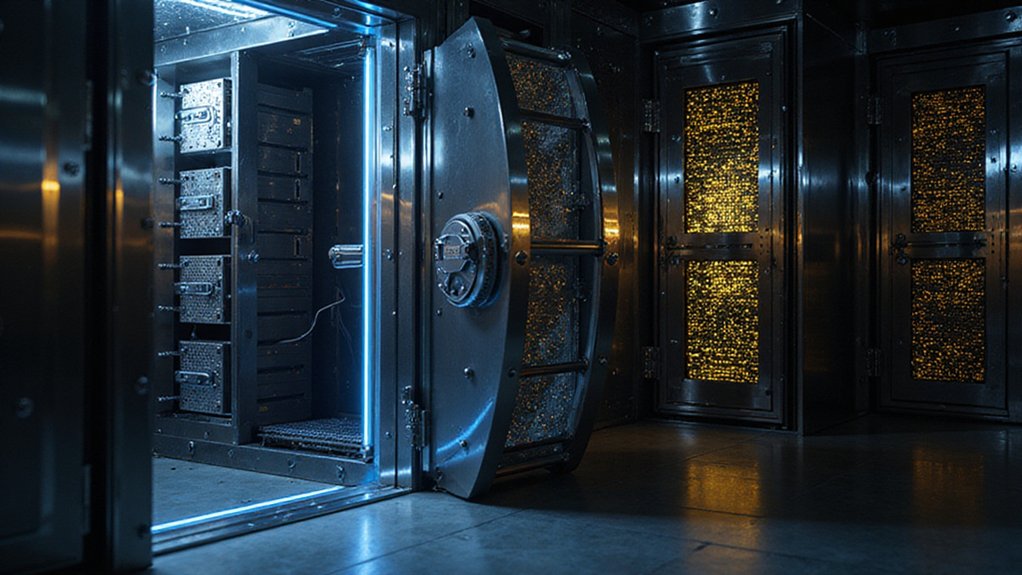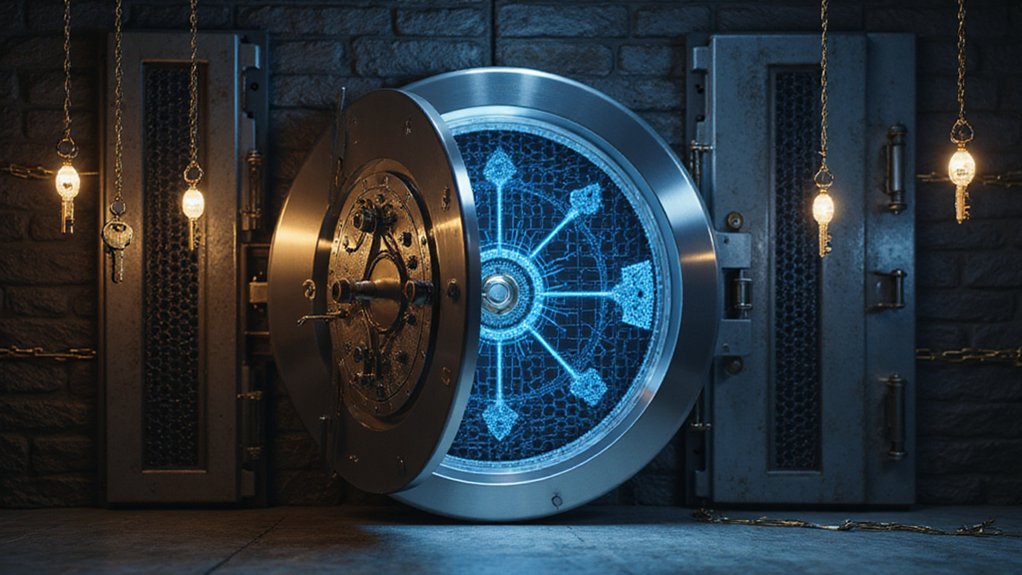Crypto custody involves the specialized management of cryptographic private keys that control digital assets—essentially determining whether investors maintain access to their Bitcoin fortunes or expensive cautionary tales. Professional custodians like Coinbase Custody and BitGo provide institutional-grade security through cold storage, multi-signature protocols, and insurance coverage, addressing the rather permanent consequence that lost keys equal lost wealth. The industry matters because it bridges traditional finance’s risk management expectations with cryptocurrency’s unforgiving technical realities, though deeper complexities await exploration.

How does one safely store something that exists only as cryptographic code scattered across a global network of computers? This peculiar question defines the core of crypto custody—the specialized process of securely holding and managing digital assets on behalf of clients or institutions.
Unlike traditional assets gathering dust in vaults, cryptocurrency custody revolves entirely around protecting cryptographic private keys, those mathematical sequences that serve as the ultimate proof of ownership in the blockchain universe.
The distinction between storage and custody proves vital here. While storage merely involves keeping something safe, custody implies active control and responsibility for authorizing transactions. Custodians fundamentally become the gatekeepers of private keys, wielding sophisticated enterprise data storage methods, hardware security modules, and multi-signature schemes to prevent unauthorized access.
Custodians become digital gatekeepers, wielding sophisticated security protocols to control the mathematical keys that represent billions in cryptocurrency value.
The irony remains stark: lose these digital keys, and the associated Bitcoin or Ethereum vanishes forever—no customer service hotline can retrieve what cryptography has permanently sealed.
Institutional investors have embraced crypto custody with particular enthusiasm, driven by regulatory compliance requirements and the sheer terror of managing private keys in-house. Professional custodians offer insurance policies against theft and loss (because apparently even mathematical abstractions need insurance), extensive audit trails, and the operational controls that satisfy institutional risk committees. Major qualified custodians like Coinbase Custody, Gemini Custody, and BitGo Trust Company have emerged as licensed providers specifically serving institutional clients who require regulatory compliance.
The complexity of safely managing cryptographic credentials has spawned an entire industry dedicated to solving problems that traditional finance never imagined.
Custody solutions span a spectrum from self-custody—where individuals maintain sole control over their private keys—to sophisticated third-party arrangements combining hot wallets for liquidity and cold wallets for offline security. The fundamental principle that “not your keys” means not your crypto underscores the critical importance of understanding who ultimately controls access to digital assets. Many self-custody wallets now offer biometric authentication as an additional security layer, requiring fingerprint or facial recognition to access stored cryptocurrencies and private keys.
Multi-signature solutions require multiple approvals before transaction execution, adding layers of protection against both external threats and internal malfeasance. Hybrid models attempt to balance flexibility with risk mitigation, acknowledging that even the most paranoid security measures must accommodate practical trading needs.
The risks addressed by crypto custody read like a cybersecurity nightmare: hacking, phishing, insider theft, technological failures, and simple human error.
Custodians respond with encryption protocols, routine security audits, geographically dispersed storage, and redundant backups—fundamentally building digital fortresses around strings of alphanumeric characters that represent billions in value.
Frequently Asked Questions
What Are the Typical Fees Associated With Crypto Custody Services?
Crypto custody fees typically range from 0.25% to 0.50% annually, with institutional providers like Coinbase commanding 0.50% alongside $1 million minimums—hardly pocket change for smaller players.
Monthly structures hover between 0.05% and 0.15%, while minimum thresholds span $100,000 to $1 million.
Additional costs for insurance, cold storage protocols, and multi-signature security features often supplement base rates, creating fee structures that reflect the premium placed on digital asset protection.
Can I Lose Access to My Crypto if the Custody Provider Goes Bankrupt?
Yes, customers can lose access to their crypto if custody providers go bankrupt.
Courts may treat custodied assets as part of the bankruptcy estate, forcing customers to become unsecured creditors—typically recovering little to nothing. The FTX debacle exemplified this risk dramatically.
While qualified custodians maintain better asset segregation (theoretically reducing this exposure), even regulated providers like Coinbase explicitly warn customers about potential bankruptcy losses in their user agreements.
How Do I Choose Between Hot Wallet and Cold Wallet Custody Options?
One evaluates transaction frequency against security requirements—frequent traders gravitate toward hot wallets despite their cyber vulnerabilities, while long-term hodlers (that peculiar crypto vernacular for “holders”) sensibly choose cold storage‘s offline sanctity.
The decision hinges on risk tolerance versus convenience: those moving crypto regularly accept hacking exposure for accessibility, while investors storing substantial amounts offline sacrifice transactional ease for security.
Budget considerations matter too—cold wallets demand upfront hardware investment.
Are Crypto Custody Services Regulated by Government Financial Authorities?
Yes, crypto custody services face increasing government oversight.
The OCC has explicitly authorized nationally chartered banks to provide cryptocurrency custody through Interpretive Letters 1170, 1183, and 1184, subjecting these activities to traditional banking regulations, fiduciary requirements, and anti-money laundering compliance.
FinCEN collaborates on enforcement standards.
This regulatory embrace—treating digital asset custody as merely another banking service—represents a remarkable evolution from crypto’s anarchic origins.
What Happens to My Cryptocurrency if I Forget My Custody Account Credentials?
When users forget custodial account credentials, their cryptocurrency doesn’t vanish into the digital ether—unlike non-custodial wallets where lost private keys mean permanent asset exile.
Custodial services typically offer recovery procedures through identity verification, password resets, and customer support channels.
The irony? Choosing custody for convenience means trading the blockchain’s immutable finality for traditional banking-style recovery mechanisms, complete with security questions and support tickets.









